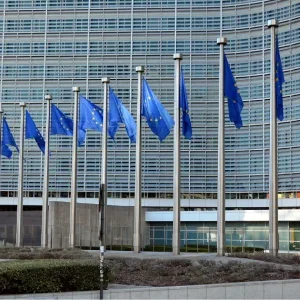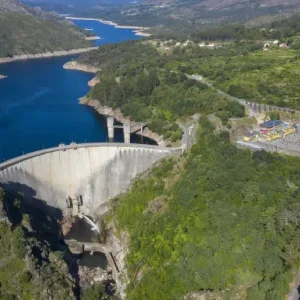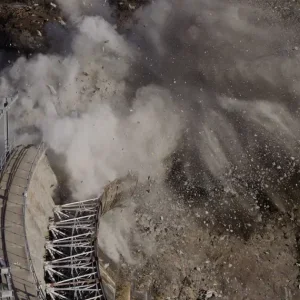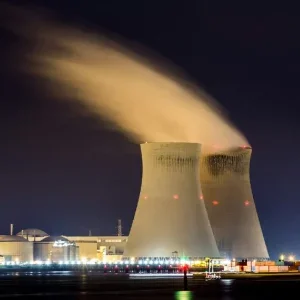At a press conference in April 1998, the World Bank’s president, James D Wolfensohn, admitted that the Yacyretá hydro power project was a ‘problem’. The Bank, which has provided a large amount of funding for this much publicised scheme, is now trying to alleviate the results of what — Wolfensohn said — ‘was not a very satisfactory project’. Dam construction can be a lengthy process but even though this scheme was conceived and designed over 25 years ago, the end to what has now become known as the Yacyretá saga, is nowhere in sight.
Project background
Born out of international co-operation between Paraguay and Argentina in 1973, the 3100MW Yacyretá project is being constructed on the Upper Paraná river. Under the Yacyretá Treaty of 1973, the Entidad Binacional Yacyretá (EBY — consisting of one Argentine and one Paraguayan utility) was created to design, build and operate the project. Major features of Yacyretá include:
•A 65km long and 42m high earth dam with a uniform elevation of 83m asl.
•A 250km long reservoir with a surface area of 1650km2 — making it one of the largest hydroelectric reservoirs in Latin America — which will involve the resettlement of 50,000 people on both riverbanks.
•A powerhouse with 20x155MW turbines and 20×172.5MVA generators.
•Two spillways with a total discharge capacity of 95,000m3/sec.
Perceived benefits of the project include, upon completion, the production of 18,940GWh of electricity a year — which will be used principally in Argentina. It has also been anticipated that Yacyretá will help control annual flooding, improve navigation and create the potential for irrigation in both Argentina and Paraguay.
Financing has been one of the most significant contributory factors to the project’s complex status. Original cost estimates by World Bank staff were set at US$3.7B in 1979 with major finance for the scheme coming from: the Argentinean government via commercial banks and creditors; the Ex-import Bank of Japan; the InterAmerican Development Bank; and the World Bank. However, since the 1970s, original project cost estimates have had to be reworked several times.
In 1992 the World Bank estimated that the total investment required for completion of the scheme would be US$5.5B. Today, this figure may be in the region of US$9-10B — depending on when and if the scheme is completed. But why is the project so far overbudget? Bill Partridge, the World Bank’s Task Team Leader for the project, explains.
‘In the interim [between the reworked cost estimates], war, hyperinflation, military coups and a variety of factors unrelated to Yacyretá have slowed and sometimes stopped the flow of public sector resources required to continue construction of the project. The bulk of the cost overruns are attributed to the interest paid on finance delays and con-tractor claims for damages due to these delays,’ he said. ‘The physical costs of the project have, in fact, changed very little.’
More controversial allegations have also been directed at the financial problems facing Yacyretá. Glenn Switkes, Latin America programme director from the International Rivers Network (IRN) went on to claim that apparently: ‘The principal beneficiaries from the project were the military dictatorships in Argentina and Paraguay who fuelled off billions of dollars from the project.’ As Partridge explained: ‘During his election campaign, the current President of Argentina, Carlos Menem, characterised the Yacyretá project as a “monument to corruption”. He also pledged to clean it up and he has done so.’
Environmental mitigation
The current state of construction at the project site is that all civil works have been completed. Twenty generating units are now in service with the reservoir operating at 76m asl, still below its optimum level of 83m asl as envisaged in the original project plans. Work remaining to be completed includes all resettlement, environmental mitigation and management measures needed to raise the reservoir to the design level.
The mention of incomplete resettlement and environmental measures indicates the problems facing the Yacyretá project, and can be traced back to financial concerns. Commenting on the factors which halted the project (see above), Partridge said: ‘These have taken the largest toll on the resettlement and environmental programmes, which were cut to continue feeding the money-hungry civil works.’
In 1984 and 1991 civilian governments re-examined Yacyretá. It was determined that it would be more expensive to cancel the project than to complete it and rectify the existing problems. Partridge said that a US$300M World Bank loan in 1992 included provisions for complete environ-mental management and resettlement plans. In September 1994 the reservoir was filled to 76m asl and the plan was to go immediately to 78m in 1995 and then 83m in 1997. ‘Unfortunately the “tequila crisis” hit at that moment,’ Partridge said, ‘and the government of Argentina took the decision to spend no more on Yacyretá and to hold the reservoir indefinitely at 76m asl.’
The crux of the problem
Partridge acknowledges that after filling the reservoir in 1994 the Bank did not take adequate action to ensure legal agreements between EBY and itself were implemented. ‘Critics of the filling of the reservoir note that the project did not complete all the scheduled resettlement and environmental works. And,’ Partridge admitted, ‘during 1995-6 Bank supervision of the resettlement and environment programmes ceased. Basic-ally, Bank policies were not enforced.’
This is the crux of the problem at Yacyretá. As one World Bank document stated in September 1997: ‘One of the basic problems was the imbalance that developed, and persists until today, between the completion of the civil and electro-mechanical works and the “complementary works” which include environment and resettlement plans. While the former are 99.8% complete, less than a third of the environmental and resettlement plans have been completed. The Yacyretá project has incurred important environmental and social liabilities that are causing increasing friction with affected populations which could have been foreseen and avoided.’
In contrast, various independent environmental agencies claim to have foreseen these problems. Sobrevivencia is a non governmental organisation that works for the protection of the environment and human rights in Paraguay. As Glen Switkes from IRN explains: ‘Sobrevivencia has been monitoring the development of Yacyretá for more than a decade. In this role, it has produced reports critical of the official project studies and project design and has worked closely with populations affected by the dam in Paraguay.’
Such close monitoring of the project led to Sobrevivencia filing a claim with the independent Inspection Panel of the World Bank in 1996. (The panel is appointed by the World Bank board of executive directors and represents the member countries of the Bank). Sobrevivencia said that, as the Banks and EBY had been unresponsive to concerns and demands of people affected by the project, it was forced to bring the claim to the attention of the Inspection Panel.
The claim was issued on behalf of those who were ‘directly, materially and adversely affected’ by the project. Adding fuel to the controversial issues surrounding Yacyretá, these individuals wanted to retain their anonymity for fear of reprisals. The request to the Inspection Panel stated that the World Bank had systematically failed to ensure that the Yacyretá project complies with the Bank’s own policies and procedures.
To some extent the World Bank has raised its hands and taken some of the blame for problems at Yacyretá. ‘By today’s international environmental standards, there can be much to criticise. Some have speculated the project would not have been built if today’s environmental standards had existed in 1973,’ Partridge said. ‘The fact that legal agreements with the Bank were clearly not enforced does not mean that the proper course of action then or now is to cancel the loans, abandon the affected families and walk away just to protect the Bank from criticism.
‘The Bank has a responsibility to the affected families to ensure that the resettlement and environmental manage-ment programmes, promised as conditions for Bank support to the construction of the dam, are fully implemented. That was the key recommendation of the Inspection Panel,’ Partridge added.
Inspection Panel report
Opponents of Yacyretá were encouraged by the Inspection Panel’s report in 1997. In February of this year, Elias Diaz Pena from Sobrevivencia said that the Inspection Panel had contributed greatly to improving relations between the World Bank and affected populations. He also spoke of greater trust between the affected people and the financial institution, aided by improved dialogue which was practically non existent before.
IRN is a little more cautious in its praise. ‘The Inspection Panel’s report itself was quite impressive in its condemnation of the actuation of EBY and the Banks but it remains to be seen what the ultimate results will be,’ Glenn Switkes said. ‘At this point the key is to involve the affected people in designing a solution which will guarantee them a decent and dignified future.’
The main recommendations from the Inspection Panel were:
•Continue all pending environmental and resettlement actions and involve the affected populations to a greater extent.
•Guarantee that Bank policies have to be respected regardless of formal ownership and management of the Yacyretá project in the future.
•Continue Bank supervision of current and future actions.
Today, criticism and various allegations still continue to be fired at Yacyretá. The recent publication of a letter written by a World Bank executive in a Paraguayan newspaper caused controversy. The letter stated that the Inspection Panel did not find the Bank in violation of its policies but the Bank’s management subsequently retracted that statement.
There is also concern that the Inspection Panel’s recommendations are not being implemented fully. Partridge, however, says this is not so. ‘The concerns of the Inspection Panel are addressed in the legal agreements signed by the two governments, EBY and the Bank in December 1997,’ he said. ‘These reformulated the resettlement and environmental programmes along the lines outlined in response to the Inspection Panel findings.’
Furthermore, Partridge added that the Bank will insist all parties abide by legal agreements and implement plans to achieve a sustainable method for operating the reservoir indefinitely at 76m asl. ‘The Bank will also form its own technical opinion as to the feasibility of, and conditions necessary for, raising the reservoir beyond that level and will advise appropriate parties,’ he explained.
Environmental organisations and the World Bank agree that there are lessons to be learnt from Yacyretá. ‘Yacyretá may go down in history as one of the world’s worst dam projects,’ Switkes said. ‘Satisfactory mitigation measures may one day be implemented but what is clear is that the experience of the populations affected by Yacyretá will be brought to bear against any new plans for dams on the Paraná river.’
Bill Partridge admitted that the World Bank has to accept responsibility for what it has helped to create at Yacyretá. ‘Pulling out of the project would have left the damage unaddressed which, in my judgement, would have been irresponsible and unethical,’ he said. Indeed he cites the following as important lessons to be learnt from the project’s turbulent history:
•Resettlement must be done prior to filling reservoirs, and not during or after.
•Expensive bi-national projects are difficult as the involved parties respond to different incentives and constraints.
•Large-scale, long-term resettlement options are complex and require flexible planning and implementation. Continual negotiations among stakeholders are necessary as conditions change.
•Civil society consultation and partici-pation make successful environmental management and resettlement, aided by the involvement of local governments.
•Money-hungry engineering works can consume all available resources and leave environmental and resettlement options starved. This risk can be overcome by strong, professional project management committed to protecting the affected people and the environment.
A sustainable future
Although remedial action is taking place at Yacyretá, the future of the controversial project still remains as uncertain as it has ever been throughout its long, drawn-out history. One fact remains clear though, project-affected people and the surrounding environment will be given more consideration. As the World Bank Inspection Panel stated in its report — remedial actions for a sustainable future at Yacyretá cannot occur too soon.
Related ArticlesSpotlight on… South America






